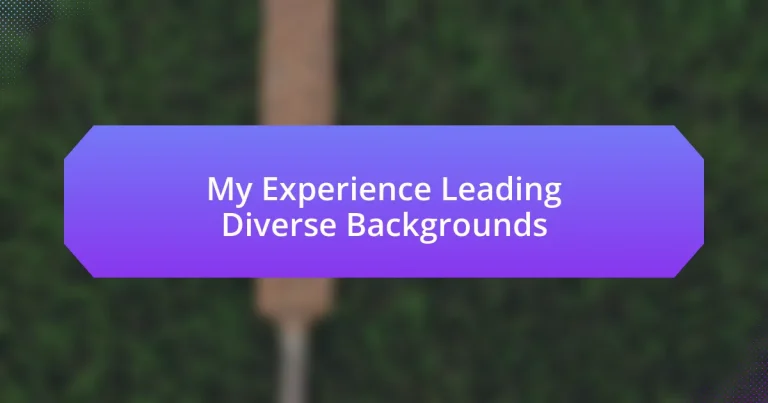Key takeaways:
- Diversity in leadership enhances creativity and innovation by leveraging unique perspectives and experiences during decision-making processes.
- Creating an inclusive team environment fosters trust and collaboration, leading to improved team dynamics and a sense of belonging.
- Effective communication, including active listening and tailored language, is crucial for bridging gaps in multicultural teams.
- Measuring success in diverse teams includes both quantitative outcomes and qualitative experiences, highlighting the importance of personal growth and empowerment.

Understanding Diversity in Leadership
Diversity in leadership goes beyond just demographic differences; it encompasses a spectrum of experiences, perspectives, and ideas that can enrich decision-making processes. I recall a time in my career when a team of individuals from various cultural backgrounds came together for a project. The vibrant discussions we had opened my eyes to alternative viewpoints, which ultimately led to a more innovative solution that none of us had initially imagined.
Have you ever witnessed a moment when a diverse group really thrived? I remember a brainstorming session where each member shared unique cultural insights that transformed our project. It wasn’t just about inclusion; it was about leveraging our differences to foster creativity and drive success.
Understanding diversity in leadership is crucial because it not only enhances problem-solving but also cultivates an environment where everyone feels valued. I once worked under a leader who actively sought out differing opinions, and it was remarkable to see how such practices not only empowered the team but also built trust and collaboration among us. This experience taught me that diverse leadership can create a thriving workplace culture, one where individuals are inspired to contribute their best.

Embracing Different Perspectives
Embracing different perspectives is not just beneficial; it often leads to unforeseen breakthroughs. During a critical project, I worked with individuals who approached problems from unique angles, like viewing a puzzle from different sides. Their insights taught me that when we invite varied opinions into discussions, we unlock creative solutions that can propel our work forward in remarkable ways.
I vividly recall a team meeting where one member introduced a concept from her cultural background that was entirely new to us. At first, there was uncertainty about how it would fit into our objectives. However, as we explored the idea together, it quickly became the cornerstone of our strategy, showcasing that unfamiliar perspectives can enrich our work. This experience solidified my belief that inclusive discussions enhance creative potential in ways we might not initially foresee.
Moreover, I’ve found that embracing different perspectives fosters a sense of belonging. One time, a colleague shared his struggles with adapting to corporate culture and how it shaped his work ethic. Listening to these different narratives made me more empathetic and aware of the dynamics at play within our team. It reminded me that diverse backgrounds contribute not just to our skills but to our collective emotional intelligence.
| Perspective | Impact |
|---|---|
| Cultural Insight | Encourages innovation and creativity |
| Personal Experience | Fosters empathy and belonging |

Building Inclusive Team Environments
Creating an inclusive team environment goes beyond merely accepting diverse backgrounds; it requires intentional actions that nurture collaboration and understanding. In my experience, I have witnessed how simple adjustments in our approach can drastically transform team dynamics. I recall a time when our team decided to implement regular check-ins, where everyone could share their thoughts and feelings openly. These sessions not only improved communication but also built trust among team members, allowing everyone to contribute without fear of judgment.
Here are some effective strategies I recommend for fostering inclusivity:
- Establish clear communication channels where everyone can express their ideas comfortably.
- Celebrate cultural diversity by organizing team events that allow members to share their traditions and experiences.
- Create a mentorship program that pairs senior staff with diverse employees, promoting knowledge sharing and growth.
- Encourage team members to participate in decision-making processes to ensure that all voices are heard.
- Regularly solicit feedback on team dynamics and make necessary adjustments to improve the inclusive atmosphere.
By actively implementing these strategies, the team environment can flourish, promoting a sense of belonging that ultimately drives success.

Strategies for Effective Communication
Effective communication is crucial when leading teams with diverse backgrounds. I’ve noticed that when I take the time to actively listen, it encourages others to do the same. Have you ever felt that surge of connection when someone genuinely hears you? This authentic engagement can break down barriers and foster an atmosphere of respect.
When I’ve worked with teams of varied cultural perspectives, I’ve found that using visual aids can significantly enhance understanding. During a recent project, we incorporated infographics to convey complex data, which made it easier for everyone to grasp the information regardless of their native language. This approach not only bridged communication gaps but also fostered a collaborative spirit, as team members could contribute to the visuals from their unique viewpoints.
It’s essential to adapt our language to be inclusive and clear, especially in a multicultural environment. I remember one meeting where I realized my technical jargon was alienating some team members. By simplifying my language and encouraging everyone to ask questions, we transformed that meeting into a productive dialogue. Isn’t it amazing how a few thoughtful adjustments can lead to deeper understanding and trust?

Encouraging Collaboration Across Cultures
When collaborating across cultures, I’ve found that creating an inclusive environment is essential. For instance, in one project, I invited team members to share their cultural traditions during meetings. This simple act not only opened up conversations but also built a sense of belonging within the group. Have you ever seen how sharing personal stories can transform a cold business meeting into a warm exchange?
My experience has shown that establishing common goals can unify diverse perspectives. I recall a time when my team faced a significant challenge with different opinions on the best approach. By taking a step back and refocusing on our shared objectives, we were able to merge our ideas creatively. It’s fascinating how aligning on a common purpose allows us to see beyond our differences and foster genuine collaboration.
Encouraging open feedback is another powerful way to enhance cross-cultural teamwork. In one instance, I implemented a rotating feedback system where team members could provide insights on each other’s ideas anonymously. The energy shifted dramatically, with many expressing how comfortable they felt sharing their thoughts. Isn’t it interesting how when people feel safe, they often provide the most valuable contributions? This approach not only elevated our discussions but also deepened trust among the team members.

Measuring Success in Diverse Teams
Measuring success in diverse teams requires a multifaceted approach. I remember leading a project where we tracked both quantitative and qualitative outcomes. We used metrics like project completion rates alongside team satisfaction surveys to gauge the effectiveness of our collaboration. It was enlightening to see how success wasn’t just about hitting deadlines but also about how valued team members felt in their roles.
Beyond traditional metrics, I discovered that the success of diverse teams often lies in the richness of the ideas generated. During a brainstorming session, I noticed that the team members from varied backgrounds brought unique perspectives that really challenged the norm. The resulting ideas were not only innovative but also led to improved solutions for our clients. Isn’t that remarkable? Seeing how diversity enhances creativity and problem-solving is both inspiring and motivating.
On a more personal note, I once organized a follow-up session after a critical project concluded. We didn’t just review the results; we engaged in heartfelt discussions about how our diverse backgrounds influenced our work experience. Some team members shared how they felt empowered to propose bold solutions they might have otherwise kept to themselves. Witnessing this transformation reaffirmed for me that measuring success is not solely about results but also about personal growth and fostering an environment where everyone feels their voice matters.

Personal Reflections on Leadership Journey
Reflecting on my leadership journey, I often find myself thinking about the pivotal moments that shaped my perspective. One incident stands out: during a team retreat, I realized how crucial it is to actively listen to diverse viewpoints. As we exchanged stories about our backgrounds, I saw walls come down, revealing vulnerabilities that transformed our collaboration into something much deeper. It’s in those moments where I learned that true leadership involves not just guiding but also being open to learning from others.
In another instance, I faced a challenging situation where two team members had conflicting ideas due to their cultural differences. Initially, I felt overwhelmed; how could I bridge this gap? But instead of choosing sides, I facilitated a dialogue that allowed them to express their views fully. The outcome was revelatory—I understood then that my role wasn’t to provide answers but to create a safe space for those discussions. It made me ponder: How often do we, as leaders, shy away from conflict rather than address it head-on?
Looking back, I can see that these experiences have enriched my leadership philosophy. Each encounter has taught me that fostering an environment of trust and openness is essential for a team’s success. I remember celebrating a small victory where we resolved a significant disagreement. It felt like a collective achievement, underscoring how the process was just as important as the outcome. Isn’t it fascinating how personal reflections contribute to a greater understanding of what leadership truly means?














